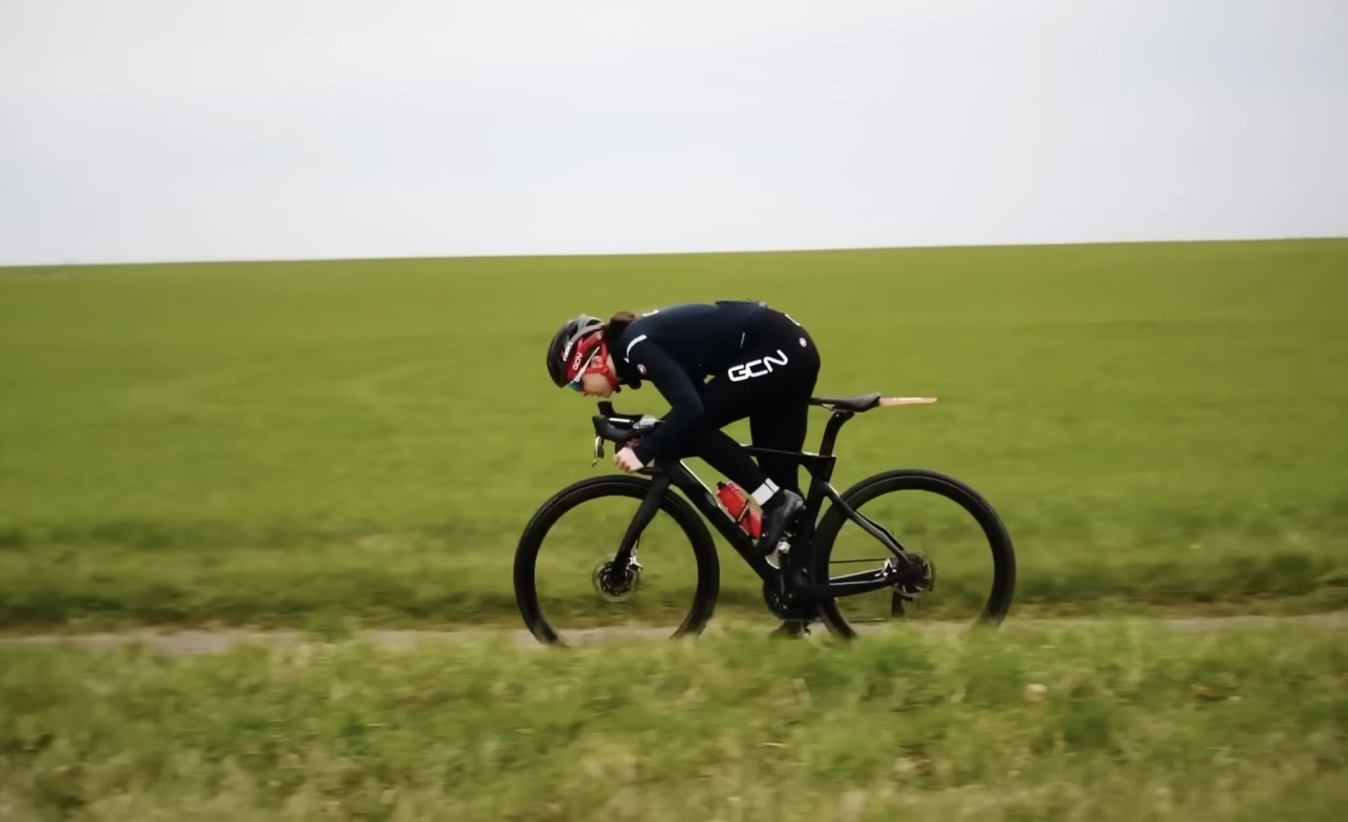Thin vs wide: which tyre is right for you?
Tyre width is an important factor, but it can be hard to know what you actually need.
James Howell-Jones
Junior Writer
A few years ago, choosing tyres was simple. It didn’t matter who you were or where you were riding, you whacked on a set of 23mm tyres, pumped them up to 120psi and got on with it. Sure, it was uncomfortable. And yes, it was slower. Oh, and there was a pretty high risk of punctures. But at least it was simple, right?
These days, things are a lot more complicated. Head out on a group ride and you’ll see riders on 25mm tyres, 32mm tyres, and anything in between. It’s dawned on us roadies that wider tyres at lower pressures are faster and more comfortable. Who knew!
But there is still a lot of debate about just how wide to go. 26mm? 28mm? 30mm? What about 32mm?
Unfortunately, there’s no one-size-fits-all solution. In this article, we’re going to break down the different factors that will determine which tyre size is right for you and the kind of riding you do.
First things first: the link between tyre width and tyre pressure

© GCN
Wider tyres allow you to run lower tyre pressures
When we talk about the comfort differences between different tyre widths, really, we’re just talking about the difference in comfort between higher and lower tyre pressures.
For example, at 120psi, you feel every bump in the road like the princess and the pea. At 50psi, the tyre deforms to absorb the imperfections in the road, and you get a smoother ride.
But on a narrower tyre, you can’t run low pressures like 50psi. If you did, it wouldn’t be long before you got a pinch flat, which is when the tyre and tube is pinched between the ground and the rim of the wheel. Worse still, in the corners, a low pressure narrow tyre would flop around and feel very unsafe.
To run lower pressures, you need a wider tyre. The general rule is that for every 2mm increase in tyre width, you can reduce the pressure in the tyres by about 10psi without increasing the risk of punctures or affecting the handling. For example, a 75kg rider might use a 26mm tyre at 75psi, a 28mm tyre at 65psi, and a 30mm tyre at 55psi.
Essentially, when we talk about the benefits of wider tyres in this article, we’re really talking about the benefits of riding at lower tyre pressure, which is only possible on wider tyres.
OK, got that? Then let’s find out which tyre width is right for you.
Riding style
There really is no one-size-fits-all solution for choosing road bike tyres. The most important thing to consider, though, is how fast you ride, and what your goals are.
1. Steady rider – sub-32kph

© GCN
For weekend warriors, 32mm is the best choice
If you generally ride at less than 32kph, there is no reason for you to choose narrow tyres. In our testing, we’ve found that wide tyres are just as efficient as narrow tyres at 30kph, so we’d advise you to get the widest tyres that your road bike will accommodate, and to pump them up to lower pressures than you would do a narrow tyre.
The test
Si Richardson set out to test the differences in efficiency between 28mm and 32mm tyres. He rode the same bike on the same course, once with 28mm tyres at 60psi, and once with 32mm tyres at 45psi. To hold 30kph, Si had to put out exactly the same amount of power for both tyre widths: an average of 154.5W.
So at the kind of speeds that most of us are travelling on a normal bike ride, a 32mm tyre at a softer pressure won’t be any disadvantage.
In fact, they come with a number of practical advantages: they’re more comfortable, they offer more grip in the corners, they have better puncture resistance, and, if you’re running tubeless tyres, they have a better chance of self-sealing if you do get a puncture.
2. Performance cyclist – above 32kph

© GCN
If you regularly ride above 32kph, narrow tyres will be more aero
If you regularly ride north of 32kph, a narrower tyre might be better. At 32kph, the aerodynamic differences between narrow and wide tyres start to have a measurable impact on your efficiency, making narrower tyres quicker.
The test
In our 28mm vs 32mm test, Si found that to maintain 40kph, he had to put out an extra 10 watts on the 32mm tyres. This is down to the aerodynamic differences between the two: fatter tyres create more air resistance, especially at higher speeds, so they aren’t as efficient at 40kph.
There is, however, a limit to this ‘narrower is faster’ idea. For outdoor riding on tarmac, if you go any narrower than 25mm, you’ll end up going slower again. It comes back to the higher pressures necessitated by thinner tyres. At these high pressures, the tyres aren’t able to deform to absorb the bumps on the road. So instead of ‘gliding’ over imperfections in the road, your bike will bump over them. Energy will be wasted on moving your bike up and down over rough tarmac, and you’ll go slower for the same power.
The goldilocks zone for most performance cyclists is 26mm. In independent testing, 26mm tyres have been shown to be the most efficient for high speed riding, which explains why most professional teams use them.

© GCN
Most modern rims are designed for wider tyres
So what width should you choose?
Ok, let's take stock: wider tyres are more comfortable, and narrower tyres are faster once you get above a certain speed. Simple, right?
Not quite. Picking tyres isn’t as straightforward as choosing between the racers’ 26mm and the leisure riders’ 32mm. There are a couple of other factors to bear in mind too:
Road surface
We’ve established that the pros ride 26mm tyres because they’re fastest. But before the biggest races of the year get under way, the worst parts of the routes are resurfaced. Apart from the infamously bumpy cobbled classics (for which most riders use fatter tyres), the pros race on freshly tarmacked roads, so 26mm tyres roll very quickly.
For the rest of us, we’ve got to make do with the roads as they are. That means contending with rough surfaces, potholes and cracks. On bad roads, 26mm tyres begin to slow us down. They might be more aerodynamic, but they are worse at absorbing the imperfections in the road, so can end up being slower than 28mm or even 30mm tyres.
If you’re a high performance cyclist, you’ve got to strike a balance. Consider the condition of the roads you ride and the aerodynamic advantages of going narrower, then choose a width that serves as a middle-man between the two.
Rider weight
For a tyre to roll quickly, it has to be inflated to the correct pressure. This ‘correct’ pressure is again something of a sweet spot, where the tyre deforms enough to absorb bumps and vibrations, but not so much that it causes increased drag.
So what is the correct pressure? Well, it depends on the width of the tyre and the weight of the rider. As a rule, though, heavier riders need higher pressures to get their tyres to that ‘correct’ level of deformation.
But with modern tyres and rims limited to around 73psi, this might mean that larger riders need to go for wider tyres, even if they regularly ride above 32kph. By choosing a larger tyre, heavier riders can get the right level of tyre deformation without exceeding the maximum pressure recommendation on their tyres.
To work this out without buying loads of tyres, use one of the many tyre pressure calculators that are freely available on the internet.

© GCN
Larger volume tyres allow for lower tyre pressures
Choosing your tyre width isn’t as simple as it used to be, but also we can now make a more informed and hopefully more comfortable choice. Thankfully, with a bit of thought about how you ride and what kind of surfaces you ride on, it’s easy to make the right decision. Ultimately, tyres wear out every couple of years, so whatever you choose, it’s not permanent.
If you’re interested in finding out more about tyre pressure and its effect on rolling resistance and handling, have a look at Si’s investigation into tyre pressure. He pitted different pressures head-to-head to find out which pressure is best.












